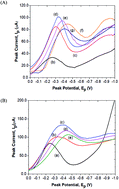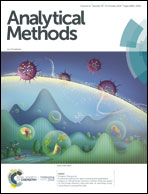Green sensors for voltammetric determination of lindane in water samples using bare and nylon 6,6 modified pencil electrodes
Abstract
Lindane, an insecticide, was determined using the differential pulse cathodic stripping voltammetry technique on bare and nylon 6,6 modified pencil electrodes. Experimental parameters, such as pH, accumulation time, accumulation potential and initial potential, were optimized. A well-defined peak of lindane was found for both electrodes which was identified at −0.338 V and −0.350 V, respectively. pHs of 8.0 and 7.0 were chosen as the optimum pHs due to a good stripping signal of the reduction peak for both bare and nylon 6,6 modified pencil electrodes. There were no significant interfering ion effects on the electroanalysis of lindane. The limits of determination for bare and nylon 6,6 modified pencil electrodes were 2.13 × 10−8 M and 3.81 × 10−8 M. The nylon 6,6 modified pencil electrode exhibited a significant increase in the stripping response toward lindane determination as compared to the bare pencil electrode. Water samples were prepared by spiking known concentrations of lindane and the recovery value achieved at both bare and nylon 6,6 modified pencil electrodes was ≥95.3% with RSDs ≤ 3.22%. Ultimately, the proposed methods were relatively selective and highly sensitive and exhibited good precision.



 Please wait while we load your content...
Please wait while we load your content...